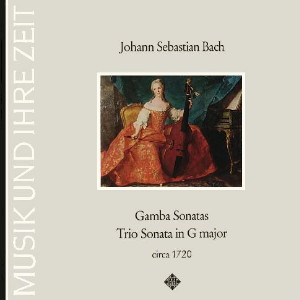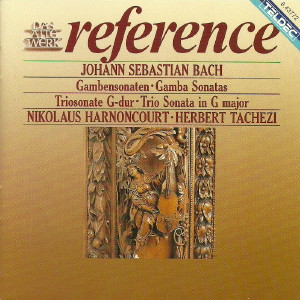 |
1 LP -
SAWT 9536-A - (p) 1969
|
 |
| 1 CD -
8.43772 ZS - (c) 1987 |
|
| Johann
Sebastian Bach (1685-1750) |
|
|
|
|
|
|
|
Gambensonaten - Sonate G-dur
(Triosonate) - um 1720
|
|
|
|
|
|
|
|
| Sonate
G-dur für Viola da gamba und Cembalo,
BWV 1027 |
|
11' 42" |
A1 |
- Adagio
|
3' 10" |
|
|
| - Allegro
ma non troppo |
3' 37" |
|
|
- Andante
|
2' 07" |
|
|
| - Allegro moderato |
3' 05" |
|
|
Sonate D-dur für
Viola da gamba und Cembalo, BWV 1028
|
|
13' 08" |
A2 |
- Adagio
|
1' 47" |
|
|
| - Allegro |
3' 40" |
|
|
| - Andante |
3' 46" |
|
|
| - Allegro |
4' 11" |
|
|
| Sonate g-moll für Viola da
gamba und Cembalo, BWV 1029 |
|
13' 52" |
B1 |
| - Vivace |
5' 33" |
|
|
| - Adagio |
4' 49" |
|
|
| - Allegro |
3' 38" |
|
|
| Sonate G-dur
(Triosonate) für Traversflöten und
B.c., BWV 1039 |
|
12' 35" |
B2 |
| - Adagio |
3' 34" |
|
|
| - Allegro ma non troppo |
3' 41" |
|
|
| - Adagio e piano |
2' 25" |
|
|
| - Presto |
3' 06" |
|
|
|
|
|
|
Nikolaus
Harnoncourt, Gambe
(Jacobus Stainer, Absam 1667) und
Violoncello (Andrea Castagneri,
Paris 1744)
|
|
| Herbert
Tachezi, Cembalo (nach
italienischen Vorbildern von
Martin Skowroneck, Bremen) |
|
| Frans
Brüggen, Traversflöte (A.
Grenser, Dresden 1750) |
|
| Leopold
Stastny, Traversflöte
(Kopie nach Hotteterre von F. v.
Huene, Boston) |
|
|
Luogo
e data di registrazione
|
| Vienna (Austria)
- marzo e aprile 1968 |
|
Registrazione
live / studio
|
| studio |
Producer
/ Engineer
|
Wolf
Erichson
|
Prima Edizione CD
|
Teldec
"reference" - 8.43772 ZS - (1 cd) - 42'
17" - (c) 1987 - AAD
|
|
Prima
Edizione LP
|
Telefunken "Das
Alte Werk" - SAWT 9536-A
- (1 lp) - 42'
17"
- (p) 1969
|
|
|
Notes
|
The viola da gamba is,
in contrast to the violin, essentially
an introvert and soft-sounding
instrument intended from the outset
for small rooms. Since this fundamental
peculiarity of the gamba was
sel-understood and generally known at
the time when the sound of all the
string instruments was amplified
(roughly from 1780), no attempt was
made then - even though success seemed
assured - to preserve the gamba for
the new era of musical dynamics, the
instrument sooner being dispensed with
altogether. The essential features of
the gamba’s tone were, however, not
known any longer when it was rescued
from oblivion at the beginning of this
century. The reinforcement of tone
that had not even been attempted a
century earlier was therefore carried
out at this time, thus robbing the
instrument of its rnost important
characteristics. There is no
possibility of replacing the gamba by
a modern instrument without upsetting
the balance, unless of course one
alters the entire instrumentation. It
is very interesting to study in Bach`s
chamber music how important or
unimportant its realization in sound
was to the composer, why a work has
been conceived for just this
instrument and no other. In any case,
only a few generations before Bach the
realization in sound was left almost
entirely to the performer - a flute
sonata for example could be played
just as well on an oboe or a violin.
Even many of Bach’s contemporaries
still composed in this manner, and as
long as the particular technical
possibilities or the special tone
‘qualities of the various instruments
were not deliberately used by the
composer, this ‘ad libitum’
instrumentation is entirely
legitimate. It is the purely tonal
aspect of the instrument that Bach
would seem to have employed most
frequently; it appears to have been of
particular importance to him. He thus
uses a violino piccolo in the First
Brandenburg Concerto without there
being any technical necessity for it,
without even exploiting all its
possibilities, and similarly a
‘scordatura’ (retuned) violin for the
G major Trio Sonata, BWV 1038 - in
these cases he was clearly only
concerned with the sound effect thus
achieved. It is similar with his use
of the viola da gamba, This instrument
was, in Bach’s time, just in the
process of being displaced from its
pedestal as the most noble and
distinguished of solo instruments, yet
it was still in fashion, particularly
in France. It seems as though the
German composers regarded the gamba
altogether differently to, for
instance, the English or the French,
who had made the gamba the most noble
and highly developed solo instrument
beside the lute and the harpsichord.
(The Italians almost completely
ignored it in favour of the violin,
and wrote practically nothing for it.)
With the exception of Kühnel and
Schenk, who followed French models,
the German composers such as
Schmelzer, Kerll, Buxtehude, Telemann
and Handel wrote technically for the
gamba just as for any other melodic
instrument; they were thus only
concerned with its distinguished tone.
Bach is entirely in this German
tradition in his treatment of the
gamba. His many solos for it in the
passions and cantatas could,
technically speaking, be performed
just as well on other instruments; he
here demands the gamba only on account
of its special sound and the
associations this evokes. The only
exception is the gamha solo in the St.
Matthew Passion (Bass aria “Komm,
süßes Kreuz”) in which the gamba is
used entirely in the manner of the
French virtuosi. Bach`s three gamba
sonatas are therefore gamba music in
an entirely different sense to the
sonatas and suites of, for instance,
Marais and Forqueray. In Bach`s gamba
sonatas the gamba and the harpsichord
are absolutely equal partners who have
strict three-part writing to perform
in such a manner that the gamba
performs one part and the two hands of
the harpsichordist the other two. This
technique of composition, which he
also applied in his violin sonatas,
was quite unusual and new for that
period, Its special feature is not so
much that the harpsiduord plays two
fully written out parts instead of the
usual continuo, but that the principal
and subsidiary voices are equally
distributed between the two
instruments, the gamba thus frequently
having to accompany the harpsichord.
----------
Bach
originally wrote the first of these
three sonatas for an entirely
different instrumental combination,
namely as a trio for two flutes and
basso continuo. Since it has also been
recorded in this form on this disc,
every listener can easily judge for
himself how much the different
instrumentation affects and influences
the essential substance of the piece.
In the flute version the two upper
parts lie at the same pitch, the bass
part being figured as in every
triosonata, and performed with
improvised harmonization. ln the gamba
version the composer has transposed
the part of the second flute an octave
downward without any major changes to
form a gamba part, the first flute and
bass parts now forming the harpsichord
part without the addition of any
chords. The strict three-part writing
naturally asserts itself far more
strongly in this version than in the
harmonized flute version. An
interesting point that clearly
demonstrates the significance of the
Italian “tempo” indications in Bach’s
time - namely that they are above all
instructions for expression - is that
the third movement of this sonata is
designated "Andante” in the gamba
version and "Adagio e piano" in the
flute version.
The Second Sonata in D rnajoris
probably the most characteristic of
all of the gamba. Even though no
chordal technique is required in it,
the technical demands of the two
Allegro movements are typical of the
instrument. ln the second, third and
fourth movements the strict three-part
writing is abandoned in places in
favour of a solo with continuo
accompaniment, as a result of which
the gamba comes more into the
foreground as a soloist. Nevertheless,
in order to underline the equality of
the partners, the big gamba cadenza
accompanied by the harpsichord in the
last movement is preceded by a smaller
one for harpsichord with gamba
accompaniment. ln this sonata the
bottom string of the gamba must be
tuned down to contra-B if it is played
on a six-string instrument.
The Third Sonata in G minor has an
almost "concertante" character. lt is
considerably more complex in its
structure than the other two sonatas.
The suspicion has been voiced in many
quarters that it has been derived from
a concerto. l would sooner regard it
as an attempt to continue to its
logical conclusion the principle begun
in the Second Sonata, the contrast
between continuo and obligato in the
harpsichord part roughly corresponding
to a concertante solo-tutti contrast.
Three-part writing again prevails in
the slow movement, though the bass
here does not participate in the motif
treatment of the two upper parts - the
gamba and the treble of the
harpsichortl. The Finale is in three
parts, each being absolutely equal in
importance as in the First Sonata.
The three sonatas are thus formally
built upon one another: the First in
pure three-part writing in which each
of the three parts is absolutely equal
in importance to the others; the
Second already treats the gamba
somewhat more in an idiom peculiar to
itself the threepart writing being
replaced in very few passages by solo
writing with continuo accompaniment;
in the Third the newly-found mode of
writing with occasional “concertante”
passages is further developed, this
form being granted absolute precedence
over the technique of the solo
instrument. This sonata has thus been
composed indeed with technical
feasibility in view, but with no
special consideration for technical
characteristics peculiar to the gamba.
The three sonatas are specifically
intended by Bach for gamba and
harpsichord. They can most easily be
performed with musical plausibility on
these instruments since the necessary
balance between the parts is
automatically present, and the garnba
in particular stands out sufficiently
from the harpsichord on the hand, and
blends most happily with its tone on
the other. Both the necessary unity
and necessary diversity of tone can
thus be sooner achieved here.
Nikolaus
Harnoncourt
|
|
Nikolaus
Harnoncourt (1929-2016)
|

|

|
|